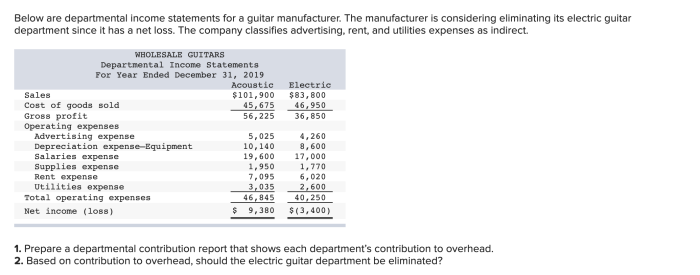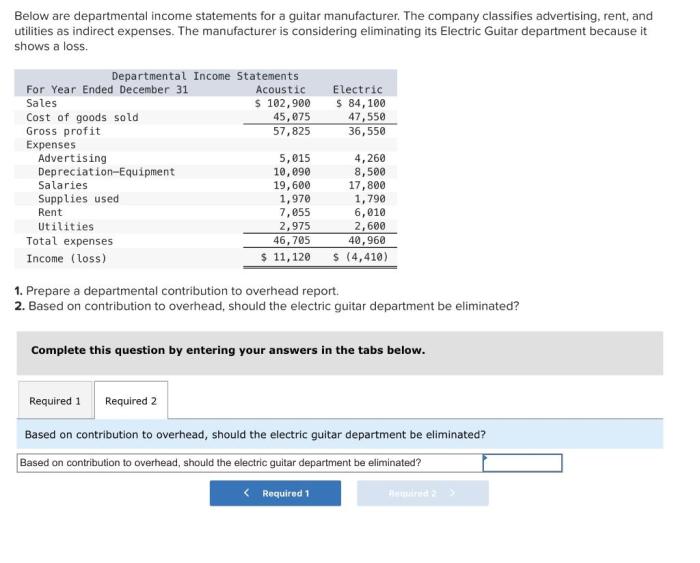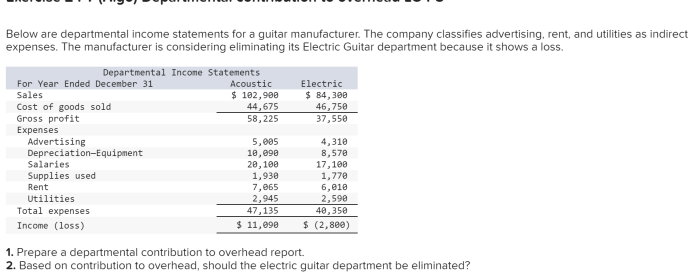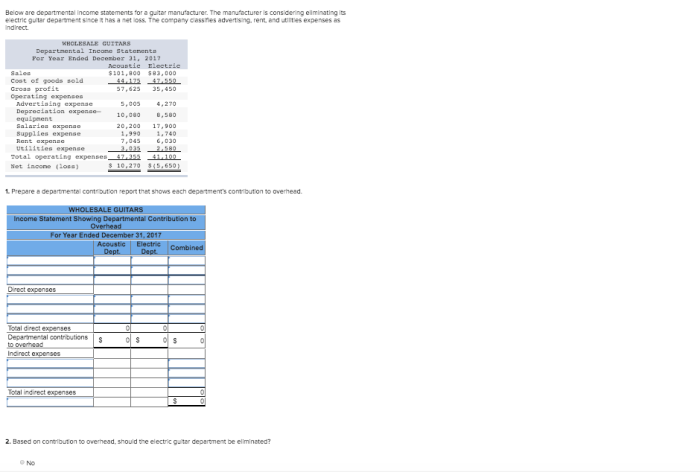Below are departmental income statements for a guitar manufacturer, providing a comprehensive overview of the financial performance of each department. This analysis delves into factors influencing performance, identifies areas for improvement, and offers cost-saving measures to optimize operations within the guitar manufacturing industry.
Our examination encompasses sales trends, cost structure, inventory management, marketing strategies, customer service, staffing, and financial reporting. By scrutinizing these aspects, we aim to uncover insights that can empower guitar manufacturers to make informed decisions, enhance profitability, and gain a competitive edge in the marketplace.
Departmental Performance Analysis: Below Are Departmental Income Statements For A Guitar Manufacturer

The departmental income statements provide insights into the financial performance of each department within the guitar manufacturing company. These statements reveal variations in revenue, expenses, and profitability among the departments.
Factors contributing to these differences may include variations in product demand, market competition, production efficiency, and marketing strategies. Identifying these factors is crucial for understanding the strengths and weaknesses of each department and implementing targeted improvement measures.
By analyzing departmental performance, management can pinpoint areas for improvement and explore cost-saving opportunities. This process involves evaluating operational efficiency, optimizing inventory levels, and enhancing marketing and customer service efforts.
Sales Trends and Projections, Below are departmental income statements for a guitar manufacturer
Analyzing sales trends helps identify seasonal patterns and other factors influencing demand. This information is essential for forecasting future sales based on historical data and market trends.
Accurate sales projections are vital for production planning, inventory management, and resource allocation. By understanding future sales patterns, the company can proactively adjust its operations to meet demand and minimize potential losses.
Cost Structure and Efficiency
Examining the cost structure of each department provides insights into areas of high cost and opportunities for cost reduction. Evaluating operational efficiency helps identify areas for improvement, such as optimizing production processes, reducing waste, and enhancing employee productivity.
By implementing cost-saving measures and improving efficiency, the company can increase profitability and gain a competitive advantage.
Inventory Management
Analyzing inventory levels and turnover rates is crucial for optimizing inventory management. High inventory levels can lead to increased storage costs, obsolescence, and potential losses. Low inventory levels, on the other hand, may result in stockouts and lost sales.
Implementing effective inventory management strategies helps ensure optimal inventory levels, minimize waste, and improve cash flow.
Marketing and Promotion
Evaluating marketing and promotional efforts is essential for assessing their effectiveness in driving sales and brand awareness. Identifying successful strategies and eliminating ineffective ones helps optimize marketing campaigns and maximize return on investment.
By understanding the impact of marketing activities, the company can fine-tune its marketing mix and achieve better results.
Customer Service and Satisfaction
Assessing customer service performance is crucial for enhancing customer satisfaction and loyalty. Identifying areas for improvement helps the company address customer concerns promptly and effectively.
By analyzing customer feedback and identifying trends, the company can implement strategies to improve customer service, reduce complaints, and build a positive brand reputation.
Staffing and Training
Evaluating staffing levels and training programs ensures that each department has the necessary resources and skills to perform effectively. Identifying any gaps in staffing or training helps the company address these issues and improve employee performance.
By investing in employee development and maintaining optimal staffing levels, the company can enhance productivity, reduce turnover, and foster a positive work environment.
Financial Reporting and Analysis
The departmental income statements provide key financial data that can be presented in tables to facilitate analysis. This data includes revenue, expenses, and profitability for each department.
By analyzing this data, management can assess the financial performance of each department, identify areas for improvement, and make informed decisions regarding resource allocation and strategic planning.
Key Questions Answered
What are the key metrics to consider when analyzing departmental income statements?
Revenue, expenses, gross profit, operating profit, and net income are crucial metrics for evaluating departmental performance.
How can departmental income statements help identify areas for cost reduction?
By comparing expenses across departments and analyzing cost drivers, manufacturers can pinpoint areas where costs can be optimized.
What role does inventory management play in departmental profitability?
Effective inventory management minimizes waste, reduces carrying costs, and ensures optimal stock levels, contributing to improved profitability.


